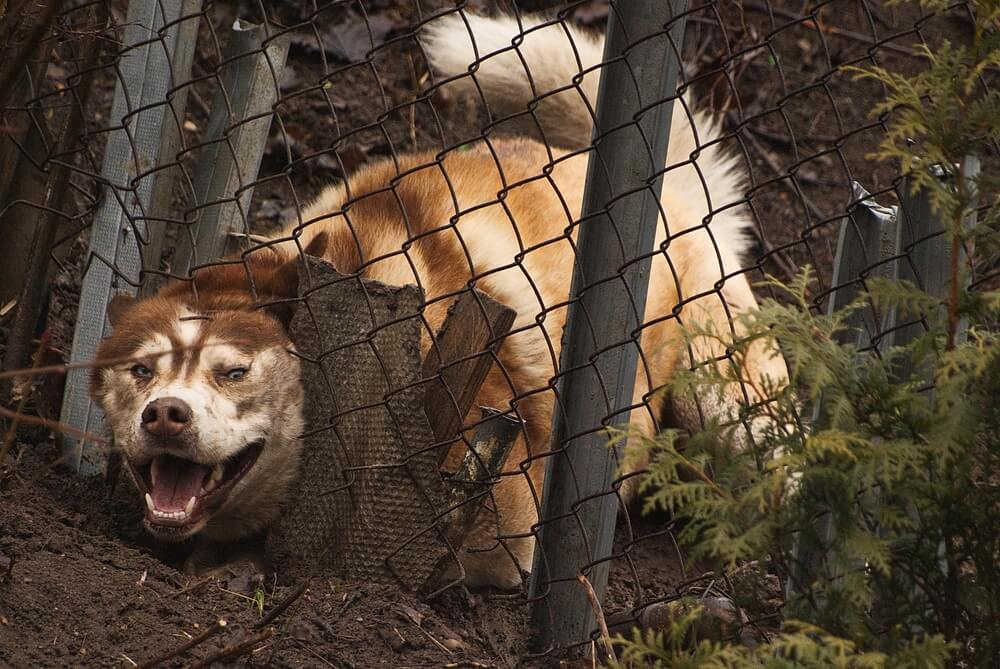Dogs were the first animals to be domesticated by humans over 30,000 years ago.
In the centuries since then, many different breeds have been developed for various purposes, such as sporting, companionship, and protection. While these characteristics have made dogs our irreplaceable companions and helpers, some bred-for behaviors do not translate well to modern home life.
One such behavior is digging.
Digging can cause destruction both inside and outside the home, and may pose a danger to dogs that escape by digging under fences or hurt themselves by digging through abrasive materials.
To stop a dog from digging, it is important to understand the motivation behind the digging behavior in order to prevent it, and it may also be necessary to use appropriate physical barriers.
Read on to learn more about why dogs dig and how to prevent them from digging under your fence.
How Can I Stop My Dog from Digging Under a Fence?
There are a number of steps you can take to keep a dog from digging under a fence by addressing the behavior, including: supervising your dog, allowing your dog to dig in areas away from the fence, making sure your dog is getting enough exercise, keeping your dog’s mind occupies.
There are also a number of steps that you can implement in your yard to keep a dog from digging under a fence, including: burying 1-2 feet of fence below the ground as part of your in-ground dog fence, running chicken wire below ground, burying large rocks below the fence in common digging areas for your dog, or potentially using concrete to keep a dog from being able to access the ground around your fence.
Here is some additional information on each of these tips which may help to minimize digging:
- To prevent dogs from digging under a fence, they should be supervised when in a fenced area. Leaving dogs unattended for long periods of time provides the opportunity for unwanted behaviors like digging.
- If possible, consider allowing dogs to dig in areas where this does not cause a problem. For example, providing a sandbox or soil patch where the dog is allowed to dig, and rewarding them when they use this area or redirecting them to this area when they dig elsewhere, should encourage dogs to dig only where acceptable. Frequent outings to the beach or dog-friendly parks can provide suitable opportunities for digging as well.
- It is extremely important that all dogs get adequate daily exercise to keep them physically stimulated because this helps decrease unwanted behaviors like digging. High energy working dogs such as border collies, Australian shepherds, huskies, German shepherds, and Belgian shepherds, among others, may require hours of intense physical activity every day. Running, swimming, hiking, playing fetch, doing agility, or taking long walks are great energy outlets to substitute for digging.
- It is also essential to keep dogs’ minds busy, especially during down time. Providing a variety of toys, utilizing food puzzles, or offering long-lasting treats such as peanut butter-filled KONG® toys can help keep dogs occupied to prevent unwanted digging behavior.
- Ridding unwanted pests like rodents or insects from inside or around the home is important to remove digging stimuli. However, do not use rodent poisons or chemicals that could be harmful to your dog if contacted or ingested.
- As dogs may dig to find a comfortable spot in hot or cold weather, they should be kept inside in these conditions.
- When possible, avoid confining dogs with separation anxiety to minimize escape-driven digging; crate training and working with a trainer or vet to manage anxiety may be helpful for these dogs.
- Spaying female dogs will prevent unwanted pregnancies, and neutering male dogs will stop them from straying in search of a mate.
What deterrents can I use to stop my dog from digging under the fence?
In some cases, physical barriers are necessary to prevent dogs from being able to dig in unwanted areas. The following dog-safe deterrents may be utilized to help stop dogs from digging under fences:
- Burying 1-2 feet of the bottom of the fence below the earth surface provides a barrier that makes it more difficult and time-consuming for dogs to successfully dig under the fence.
- Burying a few feet of chicken wire in the ground all along the base of the fence, either perpendicular to the fence or at 90 degrees to the fence bottom, prevents dogs from digging out. However, it is important to ensure that the chicken wire is anchored to the fence so that there is no gap between the chicken wire and the fence itself, or the dog could escape this way.
- The Dig Defence® can be driven into the ground along the fence perimeter to stop dogs from digging under the fence. This device consists of a line of strong steel rods that are welded together at 1.5 to 2.5 inches apart. Rod length varies from 8” to 15” depending on the size of the dog for which protection is needed.
- Partially burying large rocks around the inside perimeter of the fence can prevent dogs from accessing the ground to be able to dig there. Rocks should be very large so that dogs cannot fit them in their mouths to chew or swallow them.
- Pouring concrete along the inside perimeter of the fence may be a more drastic option, but will effectively prevent your dog from being able to dig under the fence.
Why Do Dogs Dig Under Fences?
Dogs may be motivated to dig for many different reasons:
- Dachshunds and terriers, which were bred to flush out underground burrow-dwelling animals such as badgers, foxes, and rodents, may dig because this behavior is inherent to their breed.
- Dogs have excellent hearing, and those with hunting instincts may dig if they hear an animal or insect moving underground or in the walls.
- High-energy dogs, especially those that do not get enough exercise or mental stimulation throughout the day, may dig to keep themselves busy or as a form of play.
- Anxious or fearful dogs may attempt to dig around barriers like doors or fences to escape confinement, or digging may serve as an outlet for the anxiety itself.
- Dogs may dig to bury food or toys—a behavior called “caching” that they inherited from their wolf ancestors to keep resources safe.
- In hot weather, dogs may dig into the ground to find a cool spot to lie down, and in cold weather, dogs may dig to create a warm shelter in the earth.
- Pregnant females may dig due to their nesting instinct prior to giving birth, and intact males may dig under fences to escape if they detect a female in heat nearby.
Looking for more information about dog fences? We have a library of in-depth information about various aspects of dog fences. Including tips and ideas for keeping your dog from jumping and building your own dog fence:
- 90+ creative and inexpensive dog fence ideas
- DIY dog fence ideas to build your own dog fence
- How to keep a dog from jumping a fence (or climbing a fence)
- How to keep a dog from digging under a fence
- How tall should a dog fence be?
As well as in-depth reviews of each category of dog fence (with recommendations generated by licensed veterinarians):
- The best dog fences (overall)
- The best in ground dog fences
- The best portable dog fences
- The best GPS dog fences
- The best invisible dog fences
- The best wireless dog fences
- The Best Outdoor Dog Fences
And in-depth product reviews of some of the leading dog fence brands:
Justpet dog fence containment system review
(read our review of Extreme Dog Fence as well)

